Carbon neutrality by 2030. It is a pledge made by Amherst College to tackle climate change. One of its efforts includes the Climate Action Plan (CAP).
For context, Amherst College has been and is reliant on fossil fuels. It went from individual coal boilers to centralized coal-fired steam plant to natural gas to a cogeneration plant in order to maximize efficiency of the power plant on campus. The College has invested in high-performance buildings, energy-efficient retrofits, lighting upgrades and building automations.
Now, the plan is to decarbonize the campus energy system. The Climate Action Task Force hired Integral Group, a green engineering and consulting firm, to determine the technical and financial viability of such energy transformation, summarized in the table below.
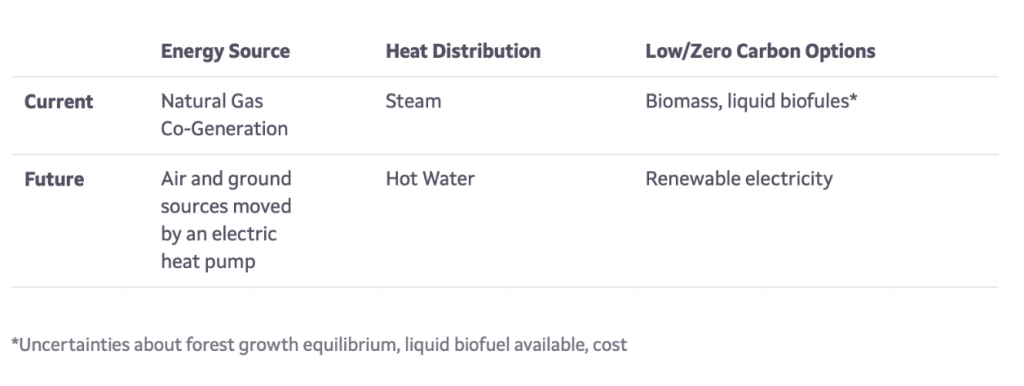
Current and Future Energy Sources and Thermal Media
The following key actions are outlined by CAP:
- Transition the campus’s heating and cooling systems from steam to low-temperature hot water (LTHW).
- Low-temperature water (120 degrees Fahrenheit) can substitute steam (which requires high-energy-content fuel) in providing heat. Safe transportation, less maintenance, and utilization of low-carbon and carbon-free sources in heating makes water a better basis for the campus’s heating and cooling systems.
- The newest buildings on campus, such as the Greenway Dorms and Science Center, have been built to accept low-temperature hot water heating. Buildings that currently operate on steam-fed heating systems need to be updated with new piping infrastructure.
- Create LTHW through ground-source heat pumps.
- These pumps take low-temperature renewable heat energy recovered from the environment and use electricity to increase the heat value of the energy. Heat pumps can also be used as chillers, moving warmer air out of a building to be cooled with low temperature renewable heat energy.
- Procure zero-emission renewable electricity to meet the campus’s heating, cooling and electrical needs.
- Currently, Amherst College generates electricity in its cogeneration system, purchasing around half of annual electricity from the grid.
- Amherst College needs to understand how much renewable power can be generated on campus, look into contract arrangements to purchase sustainable electricity, and evaluate energy, battery and thermal storage.
- Reduce our energy load and reap greater benefits from our new energy system.
- Building improvements, energy efficiency projects and behavior change will allow for financial and technical viability.
- Provide deep engagement and experiential learning opportunities related to climate action.
There are 4 phases to the CAP:

Phase I a:
- Will leverage newer or current construction projects that are largely set up to run on LTHW, including the Greenway dorms, Science Center, and the Students’ Center and dining commons.
- Other buildings will be modified to operate on LTHW, including Fayerweather Hall, Beneski Museum of Natural History, Mead Art Museum, Weiland Hall, and King Hall.
- 10 buildings conversions and connections
- Set to complete by 2022
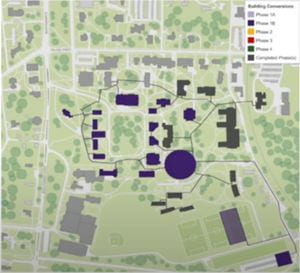
Phase I b:
- Introduce the new Energy Center, install initial geo-exchange (GHX) under the soccer fields, and institute a new network of distribution piping that loops the core of the campus
- 16 buildings conversions and connections
- More than 50% of the campus will be on the new network
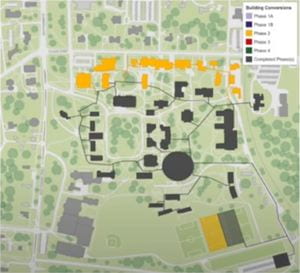
Phase II:
- Additional GHX installation
- 13 buildings conversions and connections
- Set to complete by 2026 – 2027
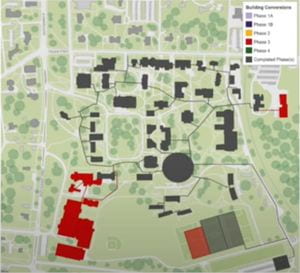
Phase III:
- Additional heat pump in Energy Center
- Decommission steam system
- Install new high-efficiency natural gas or bio-fuel LTHW boilers in existing steam plant
- 8 buildings conversions and connections
- Set to complete by 2028 – 2030
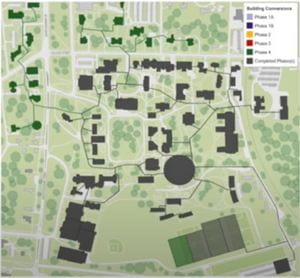
Phase IV:
- Additional heat pump and GHX installation
- Expand the central system across South Pleasant St and College St
- 19 buildings conversions and connections
- Set to complete 2031 – 2040 (base option assumption)
- Optionality: This scope could be expedited, however delaying it allows for new technologies to evolve that might be more suited to stand-alone buildings
Jim Brassord, Chief of Campus Operations, provided the campus with the most recent update on CAP. Here is a brief overview:
The Farmington facility in Maine, which creates new solar electricity in New England, has gone online. “This will reduce our CO2 emissions by more than 3,200 metric tons per year or 17.5 percent. The College had already decreased emissions by more than one-third in the past 15 years,” reports Brassord.
Recently, a construction manager performed an independent cost estimate, which was significantly more than the original done by Integral Group. This variance is influenced by the pandemic and previous underestimation of the “complexities of conducting the work in the context of our campus’s very dense and interwoven network of underground utilities.”
With the disruptions caused by the pandemic and the “inability to guarantee procurement schedules”, the start of construction of “low temperature hot water” underground piping distribution is postponed until the spring of 2023.
If you want to read a more detailed update, check your email from November 17, 2021, or visit https://www.amherst.edu/amherst-story/today/green-amherst/climate-action-plan.
Even though Brassord claims that subsequent phases can be accomplished in time to achieve the 2030 carbon neutrality goal, postponement results in timeline shifting within phases. Any further disruptions may lead to broken or, at least, bent promises. Therefore, it is our job to keep the college accountable. The student body has been a driver for social change at Amherst College for a number of years, and it is in our power to drive environmental commitment. Feel free to reach out to me, Erko Sakhiyeva, at ysakhiyeva25@amherst.edu or any other AAS Sustainability and Climate Committee member to learn more about CAP, contribute your ideas to advance sustainability on campus, or engage in meaningful discussions with like minded students who want the best for our community.
You must be logged in to post a comment.